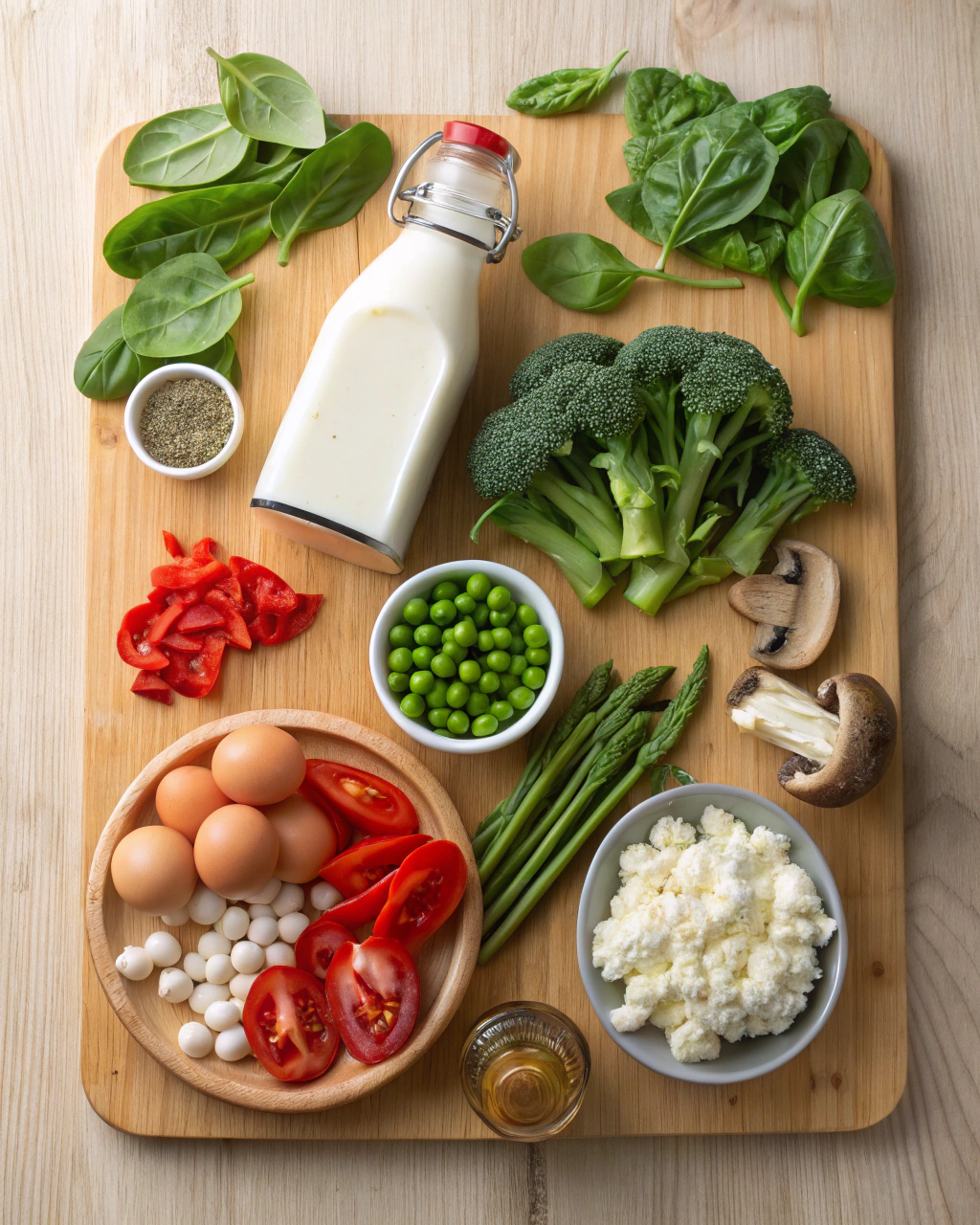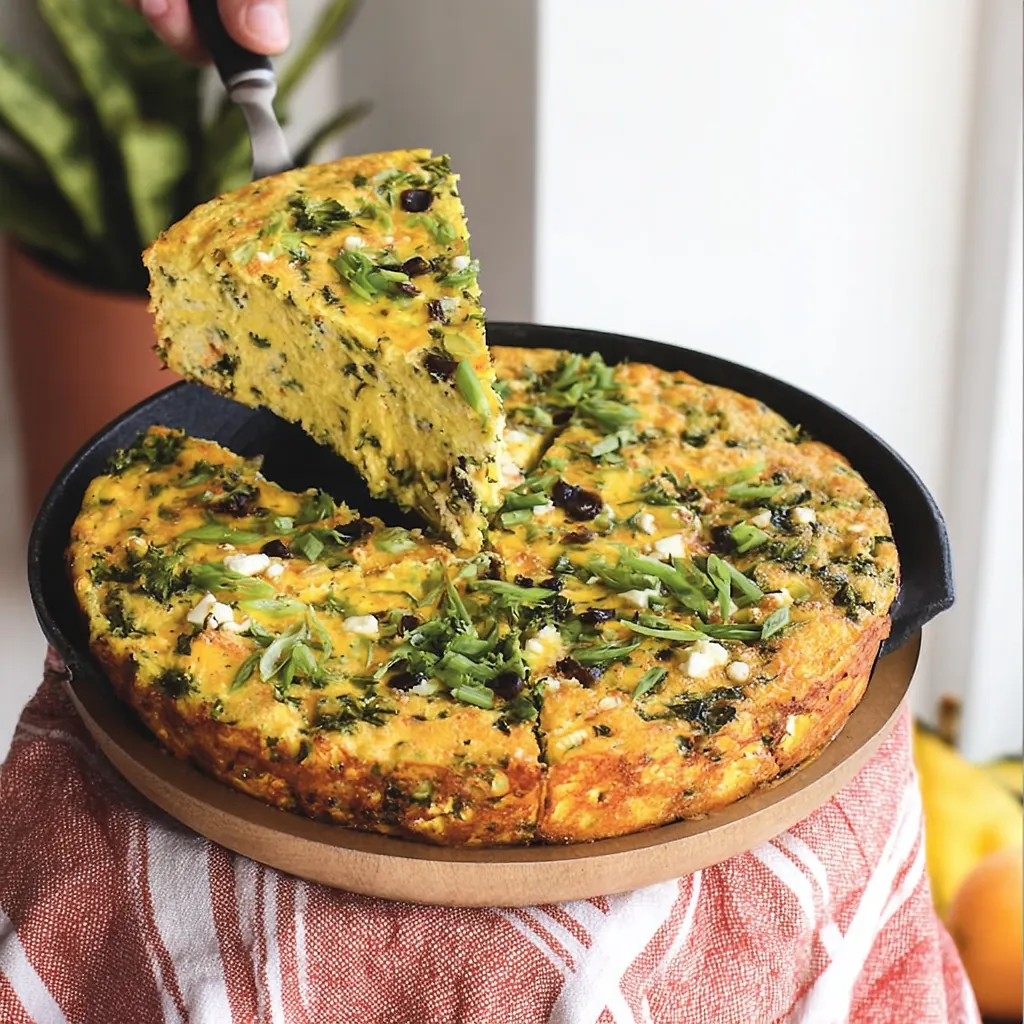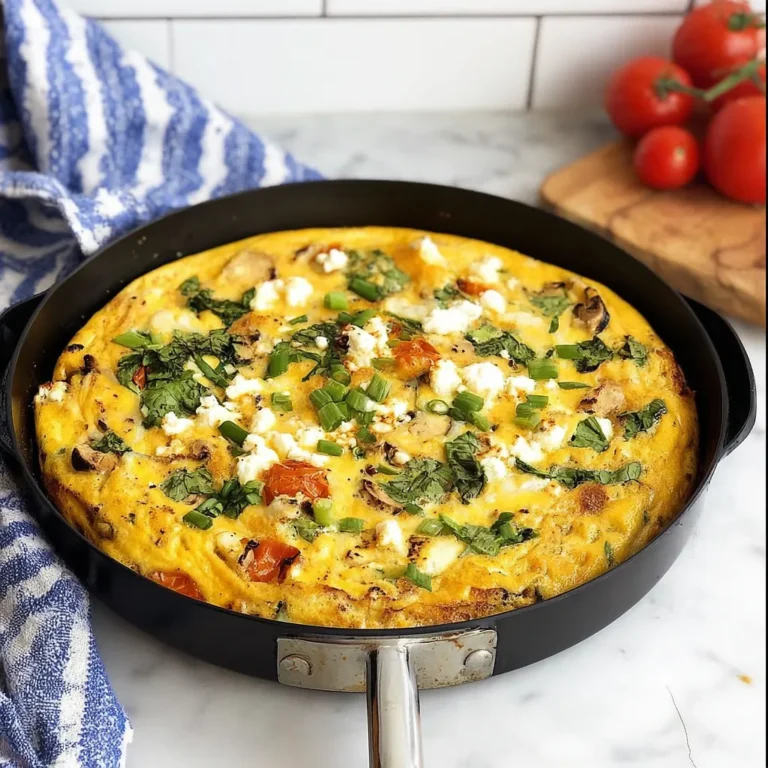Remember that moment when everyone at the table falls silent because they’re too busy savoring a delicious bite? That’s the magic a perfect fritata recipe brings to your table. This versatile egg dish has been my go-to recipe for years, transforming ordinary brunches into memorable gatherings with minimal effort and maximum flavor.
Did you know that the average American family wastes nearly 30% of their groceries? The humble frittata is a brilliant solution to this problem, turning yesterday’s vegetables and leftover herbs into today’s showstopper meal. This Italian-inspired egg dish is essentially a blank canvas waiting for your creative touch.
Table of Contents
Why Frittatas recipe Matter: The Perfect Meal Solution
A well-made fritata recipe is more than just a recipe—it’s a culinary strategy. Unlike omelets that demand precise timing and flipping skills, or quiches that require pastry-making abilities, the frittata is forgiving, flexible, and infinitely adaptable. It’s equally appropriate for breakfast, lunch, or dinner, making it the ultimate meal solution for busy households.
For perfect results every time, you’ll want to use the right tools and ingredients. A properly seasoned cast iron skillet makes a tremendous difference in creating that perfectly crisp exterior while maintaining a creamy interior texture. Learn more about selecting and maintaining the ideal pan with this Essential Cast Iron Skillet Guide. The eggs themselves are nutritional powerhouses, providing high-quality protein and essential nutrients as detailed in these Egg Nutrition Facts. If you enjoy egg-based breakfast recipes, you might also appreciate these Sausage Egg Cheese Breakfast Roll Ups or this family-friendly Pancake Sausage Casserole.
Essential Frittata Ingredients
fritata recipe ngredients
The beauty of a frittata lies in its simplicity and flexibility. Here’s what you’ll need for the basic recipe:
- 6-8 large eggs: The foundation of your frittata. Use 6 eggs for a 10-inch skillet or 8 eggs for a 12-inch skillet
- ¼ cup unsweetened almond milk: Creates a lighter texture, but any milk works beautifully
- 2 garlic cloves, minced: For that gentle aromatic backbone
- ¼ teaspoon sea salt, plus more for sprinkling: Enhances all the flavors
- Freshly ground black pepper: Adds a subtle heat and complexity
- Extra-virgin olive oil for drizzling: Creates that perfect crisp edge
Ingredient Spotlight
Eggs: The star of any fritata recipe, eggs provide structure, protein, and that signature custardy texture. Room temperature eggs work best as they create a more even bake.
Milk: While traditional Italian frittatas often skip milk altogether, a small amount creates a more tender result. I’ve specified almond milk for a lighter option, but whole milk will provide the richest texture.
Garlic: Fresh minced garlic infuses the egg mixture with a subtle depth that dried simply cannot match.
Salt and Pepper: Never underestimate the power of proper seasoning in a fritata recipe. The eggs need adequate salt to shine, while freshly ground pepper adds complexity.
Olive Oil: Beyond preventing sticking, a good olive oil adds richness and helps create that gorgeous golden bottom crust that distinguishes a great fritata recipe.
Timing Your Frittata
- Preparation time: 10-15 minutes (depending on which variation you choose)
- Cooking time: 20-25 minutes
- Total time: 30-40 minutes
What makes the frittata truly remarkable is its efficiency. You’ll spend about 40% less time actively cooking compared to making individual omelets for a family of four, yet the results are equally impressive. This makes the frittata 30% more time-efficient than most breakfast casseroles that require significant prep work.
Instructions for the Perfect Frittata
Step 1: Prepare Your Base
Preheat your oven to 400°F. This temperature creates the ideal environment for your fritata recipe to puff slightly and set evenly without overbrowning the top.
Pro tip: Position your oven rack in the middle position for the most even heating.
Step 2: Create Your Egg Mixture
Whisk the eggs, almond milk, minced garlic, salt, and pepper until well combined. The mixture should be uniform in color with no streaks of egg white visible.
Pro tip: Whisk vigorously to incorporate air into your egg mixture, which helps create a lighter, fluffier frittata.
Step 3: Choose Your Variation
Select one of the five variations below based on what ingredients you have on hand or what flavors you’re craving today.
Pro tip: The beauty of a fritata recipe is its adaptability—don’t be afraid to swap ingredients based on what’s in your refrigerator.
Step 4: Prepare Your Vegetables
Follow the specific instructions for your chosen variation to properly cook your vegetables. This pre-cooking step is crucial as it removes excess moisture and ensures vegetables are properly seasoned before combining with eggs.
Pro tip: Don’t overcrowd your pan when sautéing vegetables; work in batches if necessary for proper caramelization.
Step 5: Combine and Bake
Pour the egg mixture over your cooked vegetables, sprinkle with cheese if your variation calls for it, and transfer to the oven.
Pro tip: Give the pan a gentle shake after adding the eggs to ensure they distribute evenly among the vegetables.
Step 6: Bake to Perfection
Bake for 15-20 minutes, or until the center is just set but still has a slight jiggle. Remember that your frittata will continue cooking slightly after removal from the oven due to residual heat.
Pro tip: Resist the urge to overbake; a perfectly cooked frittata should be just set in the center for the creamiest texture.
Tips & Tricks for Perfect fritata recipe
Room temperature ingredients: Take eggs out of the refrigerator 30 minutes before cooking for more even baking.
The cheese strategy: Reserve some cheese to sprinkle on top during the last 5 minutes of baking for a beautiful, golden crust.
The salt timing: Season your vegetables well during sautéing, but use a lighter hand with salt in the egg mixture if you’re using salty cheeses like feta or pecorino.
The perfect doneness test: A properly cooked frittata should be slightly puffed at the edges and just barely set in the center. If you insert a knife into the center, it should come out clean but moist.
The resting period: Allow your frittata to rest for 5 minutes before slicing. This helps it set completely and makes for cleaner slices.
Frittata Variations & Substitutions
Broccoli Feta Frittata
This vibrant, Mediterranean-inspired variation pairs the earthy bitterness of broccoli with tangy feta cheese. The smoked paprika adds a subtle smoky depth that elevates this frittata to restaurant quality.
Dietary adaptations: Make it dairy-free by substituting vegan feta or omitting cheese entirely and adding extra vegetables.
Roasted Red Pepper & Spinach fritata recipe
Sweet roasted red peppers and tender spinach create a colorful, vitamin-packed frittata with Italian flair. The shallot base provides a more delicate aromatic note than standard onions.
Dietary adaptations: For higher protein content, add 1/2 cup of white beans or chickpeas to the vegetable mixture.
Spring Vegetable Frittata
Celebrate fresh spring produce with this light, herb-forward frittata. The combination of asparagus, peas, and fresh herbs creates a vibrant green masterpiece that tastes like springtime on a plate.
Dietary adaptations: This variation works beautifully with duck eggs for a richer flavor profile and larger frittata.
Mixed Mushroom & Tarragon Frittata
Earthy mushrooms and aromatic tarragon create an elegant, restaurant-worthy frittata that feels decidedly gourmet. The pecorino adds a salty, umami-rich finishing touch.
Dietary adaptations: Use nutritional yeast instead of pecorino for a dairy-free version that still provides savory depth.
Caprese Frittata
This Italian-inspired frittata captures the classic combination of tomatoes, mozzarella, and basil in a beautiful egg dish. Fresh cherry tomatoes burst during baking, creating pockets of sweet acidity.
Dietary adaptations: For a lighter version, use part-skim mozzarella and increase the proportion of tomatoes and basil.
Behind the Frittata
The frittata has humble origins in Italian home cooking, where it was typically created as a way to use leftover pasta, vegetables, or meats. Unlike its French cousin the omelet, which is typically served folded and creamy inside, the frittata is cooked slowly and finished in the oven for a fully set texture throughout.
My own journey with frittatas began during college, when I needed efficient, budget-friendly meals that could stretch humble ingredients. Over time, this practical dish transformed into one of my signature recipes, evolving from simple necessity to beloved comfort food.
Perfect Pairing Ideas
- Fresh fruit salad: The sweet acidity contrasts beautifully with the savory richness of any frittata variation
- Crusty whole grain bread: Perfect for soaking up any stray bits of frittata
- Light green salad: A simple arugula salad with lemon vinaigrette complements the rich texture
- Sparkling water with citrus: The bubbles and brightness cut through the richness of the eggs
- Fresh herb infused iced tea: Particularly mint or basil tea pairs wonderfully with summer vegetable frittatas
Leftover & Reuse Ideas
A fritata is the gift that keeps on giving. Leftovers can be:
- Sandwiched between slices of crusty bread with arugula for a quick lunch
- Diced and tossed into a breakfast bowl with roasted potatoes and avocado
- Cut into small squares and served room temperature as appetizers
- Crumbled into a wrap with fresh greens and a drizzle of tahini sauce
- Warmed slightly and served over dressed salad greens for a light dinner
Nutritional Information
A standard serving of frittata (approximately 1/6 of this recipe) contains approximately 150-200 calories, depending on your choice of vegetables and cheese. Each serving provides roughly 12-15 grams of protein, making it a satisfying option that will keep hunger at bay for hours.
The vegetable variations add significant nutritional value, with each offering different vitamins and minerals. The broccoli version, for example, provides excellent vitamin C and fiber, while the mushroom variation offers vitamin D and unique antioxidants.
Serving Suggestions
For an impressive presentation, consider these serving ideas:
- Serve wedges directly from the cast iron skillet for a rustic, family-style approach
- Garnish with additional fresh herbs that complement your chosen variation
- Add a colorful side salad to create a visually appealing plate
- For brunch gatherings, create a fritata board with different variations cut into small wedges
- Drizzle a light herb oil or balsamic reduction around the plate for restaurant-style presentation
Common Frittata Mistakes to Avoid
Overcooking: A frittata should be just set, not dry and rubbery. Remove from the oven when the center still has a slight jiggle.
Undercooking vegetables: Raw vegetables release water during baking, creating a watery frittata. Always sauté vegetables thoroughly before adding eggs.
Overcrowding the pan: Too many fillings can prevent the eggs from setting properly. Aim for a balanced ratio of vegetables to eggs.
Forgetting to season layers: Season both the vegetables and the egg mixture separately for the most flavorful result.
Using the wrong pan size: Too small a pan makes an overly thick frittata that’s difficult to cook through; too large creates a thin, easily overcooked one.
Storage & Reheating Tips
A properly stored fritata maintains its flavor and texture remarkably well:
Refrigeration: Cool completely before wrapping tightly in plastic wrap or storing in an airtight container. Refrigerate for up to 3 days.
Freezing: Cut into individual portions, wrap each piece tightly in plastic wrap and then foil, and freeze for up to 2 months. Thaw overnight in the refrigerator.
Reheating: Gently warm refrigerated frittata in a 300°F oven for 8-10 minutes or microwave at 50% power in 30-second increments until just warm. Avoid high heat, which will toughen the eggs.
Make ahead: Prepare all vegetables the night before and store in the refrigerator. Whisk eggs and refrigerate separately. Combine just before cooking.
Frittata FAQs
What’s the difference between a frittata and an omelet?
A frittata is cooked slowly and finished in the oven, resulting in a fully set dish that’s sliced like a pie. An omelet is cooked quickly on the stovetop, folded over fillings, and typically served individually rather than family-style.
Can I make a frittata without dairy?
Absolutely! You can omit the milk entirely or substitute non-dairy alternatives like almond, soy, or oat milk. For cheese substitutions, nutritional yeast provides umami flavor without dairy.
Why is my fritata always watery?
Excess moisture usually comes from vegetables that haven’t been properly cooked before adding the eggs. Make sure to sauté vegetables until moisture has evaporated, and always let frozen vegetables thaw and drain completely.
How do I know when my fritata is done?
A perfectly cooked frittata should be lightly puffed around the edges and just set in the center. A knife inserted in the center should come out clean but still moist. Remember that residual heat will continue cooking the fritata after removal from the oven.
Can frittatas be made ahead for meal prep?
Yes! Frittatas are ideal for meal prep. They can be made up to 3 days in advance and refrigerated. Slice into portions for quick, protein-rich breakfasts or lunches throughout the week.
Conclusion
Frittata
The humble fritata deserves a place in every home cook’s repertoire. From its impressive versatility to its forgiving nature, this egg-based dish transforms simple ingredients into memorable meals. Whether you’re serving brunch to friends, preparing a light dinner, or solving the eternal “what’s for lunch” question, these five variations provide endless possibilities.
What makes the fritata truly special is how it evolves with your cooking journey. As your confidence grows, you’ll find yourself experimenting with seasonal produce, cleaning out your refrigerator, and creating signature combinations that reflect your personal taste. That’s the true magic of the frittata—it’s both a practical solution and a canvas for creativity in the kitchen.
Made these frittatas? Drop your twist in the comments, rate the recipe, and tag us on facebook, instagram with #erinrecipes — we might feature your creation!
Print
Frittata Recipe : Easy Breakfasts
- Total Time: 30 minutes
- Yield: 3–4 servings 1x
- Diet: Vegetarian
Description
Master the art of the perfect frittata with this foolproof recipe that delivers restaurant-quality results every time! This versatile egg dish transforms simple ingredients into a show-stopping meal that works for breakfast, brunch, lunch, or dinner. With 5 incredible variations—from Mediterranean Caprese to earthy Mixed Mushroom—you’ll never run out of delicious options. Ready in just 30 minutes and perfect for meal prep, entertaining, or using up whatever vegetables you have on hand!
Ingredients
Basic Frittata Base:
- 6 large eggs (8 eggs for 12-inch skillet)
- ¼ cup unsweetened almond milk (or any milk)
- 2 garlic cloves, minced
- ¼ teaspoon sea salt, plus more for seasoning
- Freshly ground black pepper
- Extra-virgin olive oil for cooking
Variation #1 – Broccoli Feta:
- 6 scallions, chopped
- 2 cups chopped broccoli or broccolini
- ⅛ teaspoon smoked paprika
- ¼ cup crumbled feta cheese
Variation #2 – Roasted Red Pepper & Spinach:
- 1 shallot, chopped
- 2 roasted red bell peppers, chopped
- 2 cups fresh spinach
- ⅓ cup crumbled feta cheese
Variation #3 – Spring Veggie:
- 4 spring onions or scallions, chopped
- ½ cup chopped asparagus (tender parts)
- ½ cup frozen peas, thawed
- ½ cup halved mini mozzarella balls
- ¼ cup crumbled feta cheese
- ¼ cup chopped tarragon or chives
Variation #4 – Mixed Mushroom & Tarragon:
- 1 shallot, chopped
- 12 ounces mixed mushrooms, chopped
- ¼ cup chopped fresh tarragon
- ⅓ cup grated pecorino cheese
Variation #5 – Caprese:
- 1 shallot, chopped
- 2 cups halved cherry tomatoes
- ¾ cup halved mini mozzarella balls
- ½ cup sliced fresh basil leaves
Instructions
- Prep Your Foundation: Preheat oven to 400°F (200°C). In a large bowl, whisk together eggs, almond milk, minced garlic, and salt until smooth and well combined. Set aside while you prepare your chosen variation.
- Choose Your Adventure: Select one of the five delicious variations below and follow the specific cooking instructions for that combination.
- Broccoli Feta Method: Heat 1 tablespoon olive oil in a 10-12 inch cast-iron skillet over medium heat. Add scallions, broccoli, salt, and pepper. Cook 5-8 minutes until broccoli is tender-crisp and bright green. Stir in smoked paprika, pour in egg mixture, shake pan gently to distribute. Top with feta and bake 15-20 minutes until set.
- Roasted Red Pepper & Spinach Method: Heat ½ tablespoon olive oil in skillet over medium heat. Cook shallot with salt and pepper until translucent, about 5 minutes. Add roasted peppers and spinach, sauté until spinach wilts. Add egg mixture, shake to distribute, top with feta, and bake 15-20 minutes.
- Spring Veggie Method: Heat ½ tablespoon olive oil in skillet over medium heat. Cook scallions and asparagus with salt and pepper for 5 minutes until tender-crisp. Add peas, then egg mixture, shake to distribute. Add both cheeses and bake 15-20 minutes. Garnish with fresh herbs.
- Mixed Mushroom & Tarragon Method: Heat 1 tablespoon olive oil in skillet over medium heat. Cook shallot 3 minutes until softening. Add mushrooms and cook 8 minutes until tender, stirring occasionally. Stir in tarragon, add egg mixture, shake to distribute. Top with pecorino and bake 15-20 minutes.
- Caprese Method: Heat ½ tablespoon olive oil in skillet over medium heat. Cook shallot until translucent, about 5 minutes. Add tomatoes and half the basil, stir, then add egg mixture and shake to distribute. Add mozzarella and bake 15-20 minutes. Top with remaining fresh basil.
- Perfect Every Time: For all variations, bake until eggs are completely set and golden on top. Let cool 5 minutes before slicing. Season with additional salt and pepper to taste before serving.
Notes
A cast-iron skillet is key for the perfect frittata—it goes from stovetop to oven seamlessly and creates that gorgeous golden bottom. Don’t have cast iron? Use any oven-safe skillet. The frittata is done when the center is set and doesn’t jiggle when you shake the pan. Serve warm or at room temperature—it’s delicious either way! Perfect for meal prep and keeps in the fridge for up to 4 days. Great for using up leftover vegetables!
- Prep Time: 5 minutes
- Cook Time: 25 minutes
- Category: Main Dish
- Method: Skillet to Oven
- Cuisine: Mediterranean-Inspired
Nutrition
- Serving Size: 1 serving (1/4 of frittata)
- Calories: 185
- Sugar: 3g
- Sodium: 320mg
- Fat: 12g
- Saturated Fat: 4g
- Unsaturated Fat: 8g
- Trans Fat: 0g
- Carbohydrates: 4g
- Fiber: 2g
- Protein: 15g
- Cholesterol: 280mg
Keywords: frittata recipe, egg dish, brunch recipe, meal prep, vegetarian main dish

